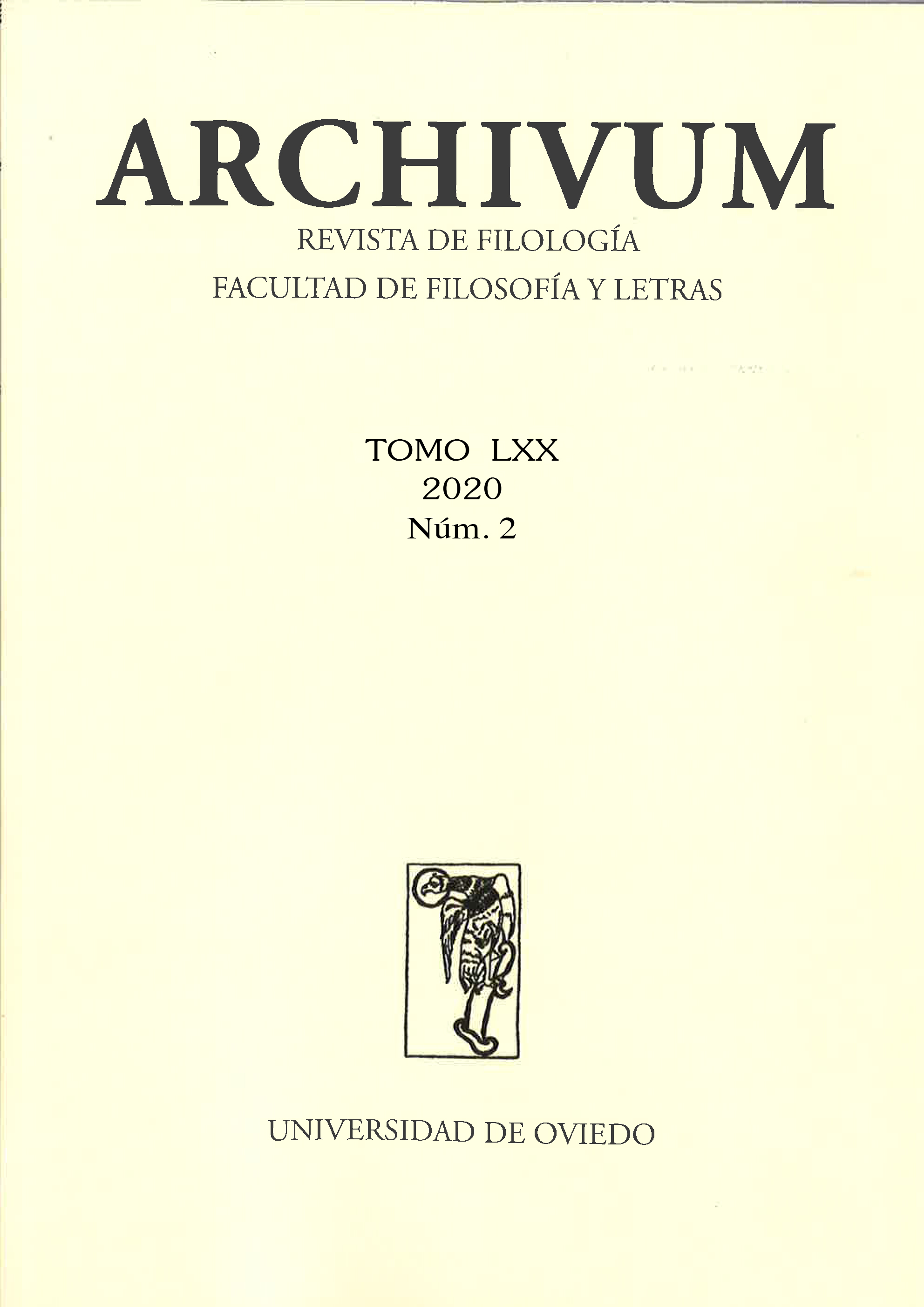Resume
El soma es uno de los elementos centrales del ritual védico. Su definición en términos de ‘bebida sagrada’ o ‘bebida divinizada’ no agota en absoluto el enorme abanico de connotaciones míticas, ideológicas y religiosas que testimonia su uso en los textos del R̥gveda. En el presente estudio —que toma como base la excelente exposición de A. Hillebrandt (1927)— ofrecemos un acercamiento filológico actualizado a sus diversos valores y funciones en el ritual, integrando en un panorama de conjunto las más valiosas aportaciones de la investigación. Tras una introducción (§ 1) en la que se expone la etimología y un esquema mitológico general, la estructura expositiva parte de los datos más concretos que contribuyen en los textos a la identificación de la planta (§ 2), para exponer después, en un orden creciente de abstracción, los elementos que configuran el ritual preparatorio y la ofrenda del soma (§ 3); el apartado final trata de sistematizar la compleja trama de relaciones mitológico-poéticas que culminan en la exaltación ideológico-sacral del soma como ‘rey’ (§ 4).Referencies bibliográfiques
Aitchison, J.E.T. (1888) Transactions of the Linnean Society of London. 2nd Ser. Botany. Vol. III, Part I: The Botany of the Afghan Delimitation Commission, London, The Linnean Society.
Anquetil-Duperron, A.-H. (1771) Zend-Avesta, ouvrage de Zoroastre, contenant les idees theologiques, physiques & morales de ce legislateur, les cérémonies du culte religieux qu’il a établi, et plusieurs traits importans relatifs à l’ancienne histoire des Perses, Paris, Tilliard.
Bergaigne, A. (1878-1883) La Religion Védique d’après les Hymnes du Rig-Veda (3 vols.), Paris, F. Vieweg Libraire-Éditeur.
Brough, J. (1971) “Soma and Amanita muscaria”, Bulletin of the School of Oriental and African Studies. 34/1, 331-362. DOI: https://doi.org/10.1017/S0041977X0012957X
Caland, W. & Henry, V. (1906-1907) L’agniṣṭoma. Description complète de la forme normale du sacrifice dans le culte védique, Paris, Leroux.
De Gubernatis, A. (1874) Letture sopra la mitologia vedica, Firenze, Successori Le Monnier.
Franz, H.G. (1990) Das alte Indien. Geschichte und Kultur des indischen Subkontinents, München, Bertelsman.
Gamkrelidze, T.V. & Ivanov, V.V. (1995) Indo-European and the Indo-Europeans. A Reconstruction and Historical Analysis of a Proto-Language and a Proto-Culture, Berlin / New York, Mouton de Gruyter.
Geldner, K.F. (1951) Der Rig-Veda, aus dem Sanskrit ins Deutsche übersetzt (3 vol. + cuarta parte a cargo de J. Nobel 1957), Cambridge, Massachusetts, Harvard University Press.
Grassmann, H. (1876-1877) Rig-Veda. Übersetzt und mit kritischen und erläuternden Anmerkungen versehen, Leipzig, F.A. Brockhaus.
Grassmann, H. (19966) Wörterbuch zum Rig-Veda, 6., überarbeitete und ergänzte Auflage von Maria Kozianka, Wiesbaden, Harrassowitz Verlag.
Hillebrandt, A. (1927) Vedische Mythologie, zweite veränderte Auflage, I. Band, Breslau, Verlag von M. & H. Marcus.
Houben, J.E.M. (2003) “The Soma-Haoma problem : Introductory overview and observations on the discussion”, Electronic Journal of Vedic Studies. 9/1, 1-47. DOI: https://doi.org/10.11588/ejvs.2003.1.783
Jamison, S.W. & Brereton, J. (2014) The Rigveda. The Earliest Religious Poetry of India (3 vols.), Oxford / New York, Oxford University Press.
Jensen, A.E. (1948) Das religiöse Weltbild einer frühen Kultur, Stuttgart, Schröder.
Kane, P.V. (1941) History of Dharmaśāstra II, Poona, Bhandarkar Oriental Research Institute.
Lehmann, J. (2000) “Die ursprüngliche rigvedische Somapflanze war weder grüne Pflanze noch Pilz: Gepresst wurden Bienenwaben. Sicht eines Entomologen”, en: Forssman B. Plath R. (eds.). Indoarisch, Iranisch und die Indogermanistik: Arbeitstagung der Indogermanischen Gesellschaft vom 2. bis 5. Oktober 1997 in Erlangen. Wiesbaden, Reichert, 295-314.
Lommel, H. (1949) “Mithra und das Stieropfer”, Paideuma. Mitteilungen zur Kulturkunde 3, 207-218. https://www.jstor.org/stable/40341243
Mayrhofer, M. (1956-1980) Kurzgefaßtes etymologisches Wörterbuch des Altindischen / A Concise Etymological Sanskrit Dictionary, Heidelberg, Winter.
Mayrhofer, M. (1992-2001): Etymologisches Wörterbuch des Altindoarischen, Heidelberg, Winter.
Müller, M. (1855) “Die Todtenbestattung bei den Brahmanen”, Zeitschrift der Deutschen Morgenländischen Gesellschaft. 9, 3/4, I-LXXXII. https://www.jstor.org/stable/43359490
Oberlies, Th. (2012) Der Rigveda und seine Religion, Berlin, Verlag der Weltreligionen im Inselverlag.
O’Flaherty, W.D. (1981) The Rig-Veda. An Anthology, London.
Oldenberg, H. (1894) Die Religion des Veda, Berlin.
Oldenberg, H. (1912) Ṛgveda. Textkritische und exegetische Noten. Siebentes bis zehntes Buch, Berlin, Weidmannsche Buchhandlung.
Puhvel, J. (19932) Comparative Mythology, Baltimore / London, Johns Hopkins University Press.
Rix, H. & al. (20012) Lexikon der indogermanischen Verben. Die Wurzeln und ihre Primärstammbildungen, Wiesbaden, Reichert.
Scarlata, S. (1999) Die Wurzelkomposita im R̥g-veda, Wiesbaden, Reichert.
Schlerath, B. (1960) Das Königtum in Rig- und Atharvaveda. Ein Beitrag zur indo-germanischen Kulturgeschichte (Abhandlungen für die Kunde des Morgenlandes 33/3) Wiesbaden, F. Steiner.
Schlerath, B. (1987a) “rákṣate śíraḥ RV 9,68,4”, Studien zur Indologie und Iranistik. 13/14, 195-200.
Schlerath, B. (1987b) “The Slaying of the God Soma”, Annals of the Bhandarkar Oriental Research Institute. 68 (reprint), Ramakrishna Gopal Bhandarkar 150th Birth-Anniversary Volume, Poona, 345-348.
Shah, N.C. (2015) “Soma, an Enigmatic, Mysterious Plant of the Vedic Āryas: An Appraisal”, Indian Journal of History of Science. 50/1, 26-41. DOI: 10.16943/ijhs/2015/v50i1/48110
Stein, A. (1931) “On the ephedra, the Hūm plant, and the Soma” Bulletin of the School for Oriental and African Studies. 6, 501-514. https://www.jstor.org/stable/607681
Stuhrmann, R. (1985) “Worum handelt es sich beim Soma?” Indo-Iranian Journal. 28, 85-93. https://www.jstor.org/stable/24654022
Stuhrmann, R. (2006) “R̥gvedische Lichtaufnahmen. Soma botanisch, pharmakologisch, in den Augen der Kavis”, Electronic Journal of Vedic Studies. 13/1, 1-93. DOI: https://doi.org/10.11588/ejvs.2006.1.2150
Van Nooten, B. & Holland, G. (1994) Rig Veda. A Metrically Restored Text with an Introduction and Notes, Cambridge, Massachusetts, Harvard University Press. https://liberalarts.utexas.edu/lrc/rigveda/index.php
Wackernagel, J. & Debrunner, A. (1896-1957) Altindische Grammatik, Göttingen, Vandenhoeck & Ruprecht.
Wasson, R.G. (1969) Soma: Divine Mushroom of Immortality, New York, Harcourt Brace. & World.
Witzel, M. & Gotō, T. (2007) Rig-Veda. Das heilige Wissen. Erster und zweiter Liederkreis. Aus dem vedischen Sanskrit übersetzt und herausgegeben von M.W. und T.G. unter Mitarbeit von E. Dōyama und m. Ježić, Frankfurt am Main / Leipzig, Verlag der Weltreligionen im Inselverlag.
Zimmer, H. (1879) Altindisches Leben. Die Cultur der vedischen Arier. Nach den Saṃhitā dargestellt, Berlin, Weidmannsche Buchhandlung.
Zimmer, H. (1995) Mitos y símbolos de la India, ed. a cargo de Joseph Campbell, trad. de Francisco Torres Oliver, Madrid, Ediciones Siruela.

Esta obra ta baxo una llicencia internacional Creative Commons Reconocencia-NonComercial-EnsinDerivaes 4.0.
Derechos d'autor (c) 2021 Archivum


